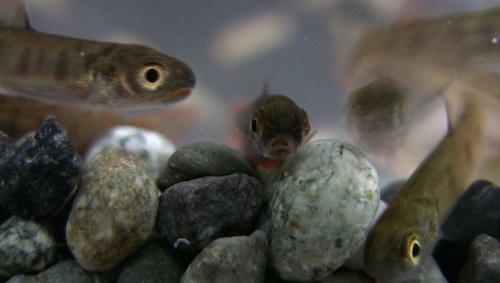 Intelligent Design
Intelligent Design
A Salmon Called Indomitable

They called him Indomitable. This Coho salmon’s migratory adventure seems almost impossible to believe, but it’s not just an old fish tale — it’s true. Illustra producer Lad Allen and editor Jerry Harned documented the story back in the VHS days of 1992. When planning the new documentary Living Waters: Intelligent Design in the Oceans of the Earth a couple of years ago, Lad was hoping to retell it in high-definition, but the constraints of time often call for painful decisions that leave good material on the cutting room floor. We can at least share this and other stories in words.
At the Prairie Creek Fish Hatchery on the northern California coast, workers were surprised on the morning of December 2, 1964, to find a large male Coho salmon swimming among juveniles in a concrete rearing pond. It had the distinctive mark on its fin of fish raised in this particular pond. The puzzle was how it got there. The only route was a vertical pipe that drained the pond’s overflow out into Lost Man Creek behind the hatchery, which joined Prairie Creek and then Redwood Creek before flowing into the ocean. Scientists retraced this fish’s route to figure out what it would have had to do to make it into the pond.
As Living Waters shows, a juvenile salmon imprints on the distinctive odor of its birthplace before it heads downstream. Water from a salmon’s natal stream produces a powerful neurological response when dripped into its nasal cavity, but other samples do not — even those from nearby streams. Indomitable’s rearing pond had a unique chemical “bouquet” this fish had locked into its brain. The fish and its peers had been taken a couple of years earlier from the rearing pond and released into the ocean, but that scent would not be forgotten.
After two years, driven by the instinct to spawn, Indomitable made its way back from the deep ocean to the mouth of Redwood Creek where it had been released. The odor from home would have been very faint as it adapted its biology from salt water to fresh water for a few days. Swimming upstream three miles, the salmon faced a decision at the junction of Redwood and Prairie Creeks. The growing scent of home made it choose to continue north. Another 1.5 miles ahead, the shortest route would have been to turn onto Lost Man Creek that goes under the highway 100 yards to the east — but that route had been blocked by floods from a winter storm.
Up Prairie Creek, however, water from the rearing pond trickled out of a culvert passing under Highway 101. Heavy rains that year increased the trickle to a small channel nine inches deep. Indomitable swam up that channel, fighting vegetation along the way. Then it entered a storm sewer, requiring a jump into a 12-inch pipe under the hatchery’s parking lot. It seemed like a hopeless dead end, but the fish continued on, only to find another obstacle. The only path forward, following the scent, was a concrete flume that seemed like a dead end. The fish hunted till it found a 4-inch drain pipe. Squirming through the pipe, the fish hit the worst obstacle of all.
The pipe now made a 90-degree bend upward. The fish was now three feet below its home, but would have to jump and wriggle straight up to make it. Then, to make matters worse, its path was blocked by an 8-pound frame screen covering the top of the pipe. The screen weighed five times more than the fish itself. Somehow, Indomitable must have rammed the screen over and over with its head, jumping upward in that narrow vertical pipe, until it dislodged the screen, allowing it to wriggle out into the pond. That’s where workers found him that December morning, swimming alongside the hatchlings.
“And now,” as Paul Harvey would say, “the rest of the story.” Amazed as they were by this salmon’s persistence, the workers had another surprise coming. As they were trying to reconstruct Indomitable’s route back to the hatchery, they decided to lift some of the boards covering the drainage flume. What they found stirred their imaginations with awe and wonder. Another 72 Coho salmon, each with the distinctive fin clip of the rearing pond, were trapped in the channel, having made it all the way back save for that final narrow pipe with its vertical leap.
When Lad Allen returned to the site and talked to the staff years later, he was shown a jar where Indomitable had been preserved in memory of its Olympic feat. The fish hatchery is now gone, but we thought Indomitable’s story makes a great follow-up anecdote to illustrate the olfactory genius designed into the Pacific salmon: its ability to detect extremely dilute odor molecules, its incredible memory, and its instinct that can drive it home despite seemingly insurmountable obstacles.
National Geographic posted a “Friday Fact” that claims that “a salmon’s sense of smell is thousands of times better than a dog’s.” One part per billion is equivalent to one tablespoon of salt dissolved in a volume equal to 18 Olympic-size swimming pools. As Timothy Standish says in Living Waters, the fish can probably detect odors at that level, and perhaps parts per trillion (equivalent to a fingernail’s width compared to the diameter of the earth). These specifications far exceed the requirements of mere survival. Intelligent design can build such systems; tinkerers and blind watchmakers cannot.
If you missed our Pacific Northwest premiere, don’t despair; Living Waters is now available on DVD and will soon be out on Blu-ray. Consider setting up your own premiere for your neighborhood or organization.
Image: Salmon hatchlings via Illustra Media.
